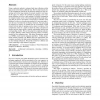Free Online Productivity Tools
i2Speak
i2Symbol
i2OCR
iTex2Img
iWeb2Print
iWeb2Shot
i2Type
iPdf2Split
iPdf2Merge
i2Bopomofo
i2Arabic
i2Style
i2Image
i2PDF
iLatex2Rtf
Sci2ools
AFRIGRAPH
2003
ACM
2003
ACM
Efficient clustering and visibility calculation for global illumination
Using a radiosity method to estimate light inter-reflections within large scenes still remains a difficult task. The two main reasons are: (i) the computations entailed by the radiosity method are time consuming and (ii) the large amount of memory needed is very large. In this paper, we address this problem by proposing a new clustering technique as well as a new method of visibility computation for complex indoor scenes. Our clustering algorithm groups polygons that are close to each other in each room (or corridor) of the building. It relies on a classification method of k-mean type and allows the use of several kinds of distance functions. For each group of polygons (or cluster), we estimate the set of potentially visible clusters with the help of openings such as doors or windows. This computation results in a graph in which the nodes correspond to clusters and the edges express visibility relationships between the corresponding clusters. We use this graph for computing radiosity ...
AFRIGRAPH 2003 | Algorithm Groups Polygons | Multi-wavelet Radiosity Algorithm | Radiosity Methods | Virtual Reality |
| Added | 23 Aug 2010 |
| Updated | 23 Aug 2010 |
| Type | Conference |
| Year | 2003 |
| Where | AFRIGRAPH |
| Authors | Daniel Meneveaux, Kadi Bouatouch, Gilles Subrenat, Philippe Blasi |
Comments (0)

